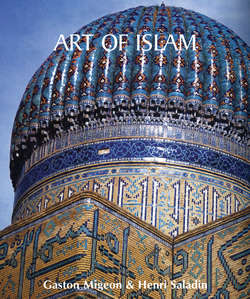Читать книгу Art of Islam - Gaston Migeon - Страница 9
На сайте Литреса книга снята с продажи.
Architecture
A – The Near and Middle East
Damascus
ОглавлениеThe Umayyad Mosque, or Great Mosque of Damascus, is an ancient Christian church dedicated to John the Baptist by Theodosius in 379, and restored by his son Arcadius on the site of an ancient temple that stood in the middle of an immense court, and whose porticos are still partly standing. Upon their entry into Damascus, Muslims used this mosque jointly with Christians; however, the Umayyad caliph El-Yalid devoted it entirely to Muslim worship and, to this effect, slightly altered it.
The upper part of the mosque’s interior has Byzantine-style stanchions with very flat surfaces, a frieze made of white marble and gilded rinceaus (ornamental bands of scrolled foliage) that spread against a background of dark marble that actually brings to mind the Qubbat al-Sakhrah. The piers surmounting the column capitals are like truncated pyramids but more massive than those outside. The ceilings of the transept wings before the most recent destructive fire were made of exposed, overhanging beams; semi-cylindrical beams that were connected to the square parts by gilded stalactites (like those in 15th-century Cairo) spanned between a frieze decorated with an inscription in white letters on a blue background, supported by consoles decorated with red, blue and gilded ornaments. This beautiful work undoubtedly dates back to the 15th century renovation, which included the mihrab, the minbar and the mosaics that decorated the lower part of the wall. Nothing, however, was as attractive as the transept’s mosaics, which had been given to Walid by the Greek emperor and laid by Byzantine mosaic workers; they had a green and brown tone on a gilded background. The sheiks of the mosque claimed that these mosaics represented Mecca and Medina. Thanks to this splendid exteriour finish, the Great Mosque of Damascus, viewed from the courtyard, had a magnificent appearance.
As lavishly decorated as Cairo’s mosques were, its palace complexes were equally as stunning; should we agree with the description of historians, the Arab Muslims sought in every way to surpass the extreme luxury of Byzantine emperors.
